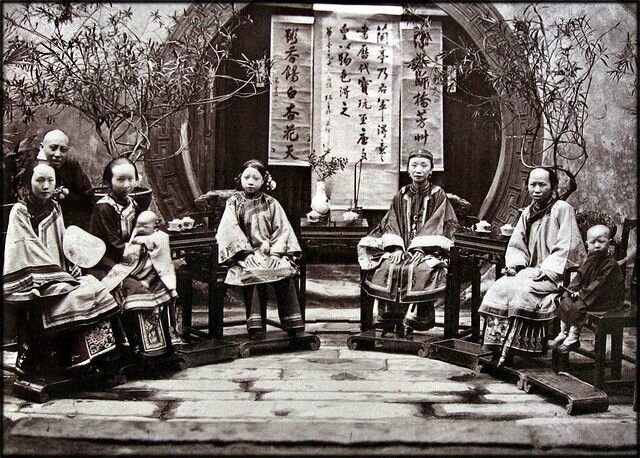Chinese Family, c.1875
Chinese Family, c.1875.
Iin The Face Of China As Seen By Photographers & Travelers 1860-1912, authored by L. Carrington Goodrich, with historical commentary by Nigel Cameron.
Knowing nothing at all of the actual people; that is, who they were or what social or political connections they had, we can only make educated assumptions and guesses about their milieu, based on what is believed or understood about Chinese culture during the late 1800's. From the outset, the viewer is particularly struck by the rather formal arrangement of the seated individuals, and then immediately notes the contrasting inconsistency offered by the starkly informal positioning of the man to the left rear. Further, the setting itself is rather peculiar; the seating is positioned directly in the path of a moon door walkway, which one sees is a part of a weathered wall. One then realizes that this setting is outdoors, perhaps located in a private courtyard, and was most likely artificially arranged for the purpose of the photograph. The wet ground between the paving stones reinforces that the setting was outdoors. It was likely chosen because the visual impact of the doorway lent itself to the creative thought process of the photographer, as well as the practicality of affording enough light to record the image.
The purpose of the photograph is another issue. In our present day, a picture being recorded is so uncomplicated and common that we give it scant thought. However, we must appreciate that to the people of those times, being recorded in a photograph was as unlikely and as monumental an undertaking for them, as perhaps a ride on the space shuttle would be for us. My speculation is that the photographic session was arranged for by the man in the photograph to the left. In my view, he is definitely the master of this house, and the others in the picture were his wives and children. The photographic opportunity was likely initiated as an effort to produce a record of his family, as it became highly fashionable for affluent Chinese in the late 1800's to have such portraits taken. The man is standing to the rear (normally a servant's position), but by his very nonchalant stance, and to be so close in physical proximity, that is, to be nearly draped over one of the ladies of the house; reveals clearly that he is not one of the household help, but also reveals that he was not intended to have been in the picture. That is, had he been intended or would have been planned to be in the picture in the first place, where should one expect him to be? I would think that he should have belonged in the center of the photograph, occupying the most important position of all, telling anyone who sees it that he is the master of this setting. So, on that basis, I surmise that this was first intended to be a picture of only the wives and children, and not of him at all.
So, if that was the case, what then, is he doing in the picture? His positioning to the far left side is telling. My hypothesis is, that similar to spectators at crime or accident scenes, the man was so caught up in his curiosity to observe that he failed to realize that he had strayed into the scene and had become a part of the event. The look of the man's face strongly suggests that he was so raptly focused on what the photographer was doing, that he didn't know that he had stepped out of the sidelines and had put himself into the picture. One can only imagine that had the man not been so hypnotically distracted to have thus entered the picture, how much poorer the image would have been.
Socially, the furniture belies a family of some affluence. The wooden foot stools at the time were used not for the height challenged but rather to provide insulation against having to put one's feet onto a cold and unheated floor. The man has four wives, all of which seem to have bound feet (except for one who's feet we cannot see) bespeaking already his ability of a high degree of financial security. In the center, the most politically powerful position in any family portrait, is probably the first wife. Seated next to her is the eldest child, likely the first wife's daughter. To the far right is probably the second wife based on appearance of age. Next to her is probably her son, whose importance as heir mandated that despite his reluctance, his presence in the photograph was a considered must. This is evidenced by the notable steadying hand against fidgetting, of an off camera person (probably a servant) holding him in position. On the far left, the two seated ladies are likely wives three and four, with wife (probably) three, holding the third child of the house (borne from her), on her lap. The remaining wife was childless to that point, but still had her youth. The fine embroidary of their clothing further reinforces that these were women of importance, that is, they were all wives and not a wife's personal maid attendant or any member of the serving class.
(Source: ralph repo)

/https%3A%2F%2Fprofilepics.canalblog.com%2Fprofilepics%2F1%2F0%2F100183.jpg)
/https%3A%2F%2Fstorage.canalblog.com%2F03%2F02%2F119589%2F96711876_o.jpg)
/https%3A%2F%2Fstorage.canalblog.com%2F11%2F31%2F119589%2F94773502_o.jpg)
/https%3A%2F%2Fstorage.canalblog.com%2F20%2F83%2F119589%2F94772815_o.jpg)
/https%3A%2F%2Fstorage.canalblog.com%2F26%2F72%2F119589%2F75604929_o.jpg)
/https%3A%2F%2Fstorage.canalblog.com%2F59%2F60%2F119589%2F26458628_o.jpg)



/image%2F1371349%2F20240514%2Fob_bdb407_e812351f-5f49-4757-8878-03fd6745ece7.jpg)
/image%2F1371349%2F20240514%2Fob_7b420e_telechargement-12.jpg)
/image%2F1371349%2F20240514%2Fob_79c130_telechargement-8.jpg)
/image%2F1371349%2F20240514%2Fob_427040_telechargement-5.jpg)